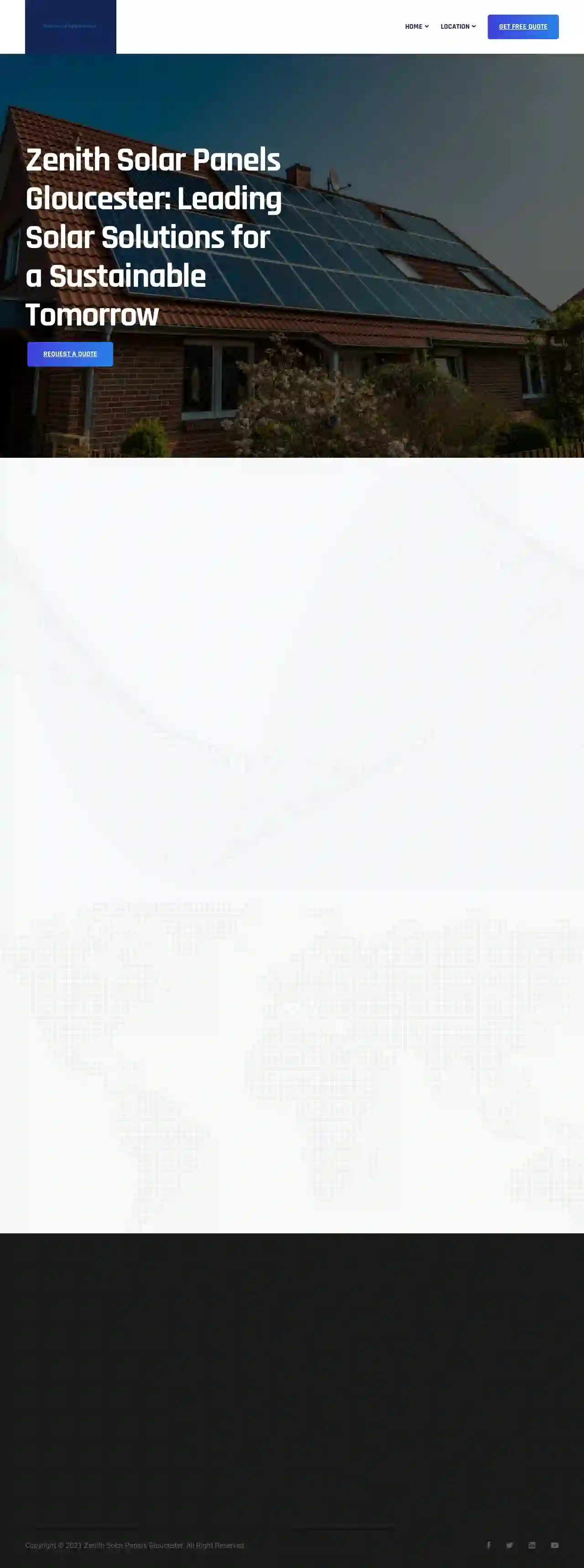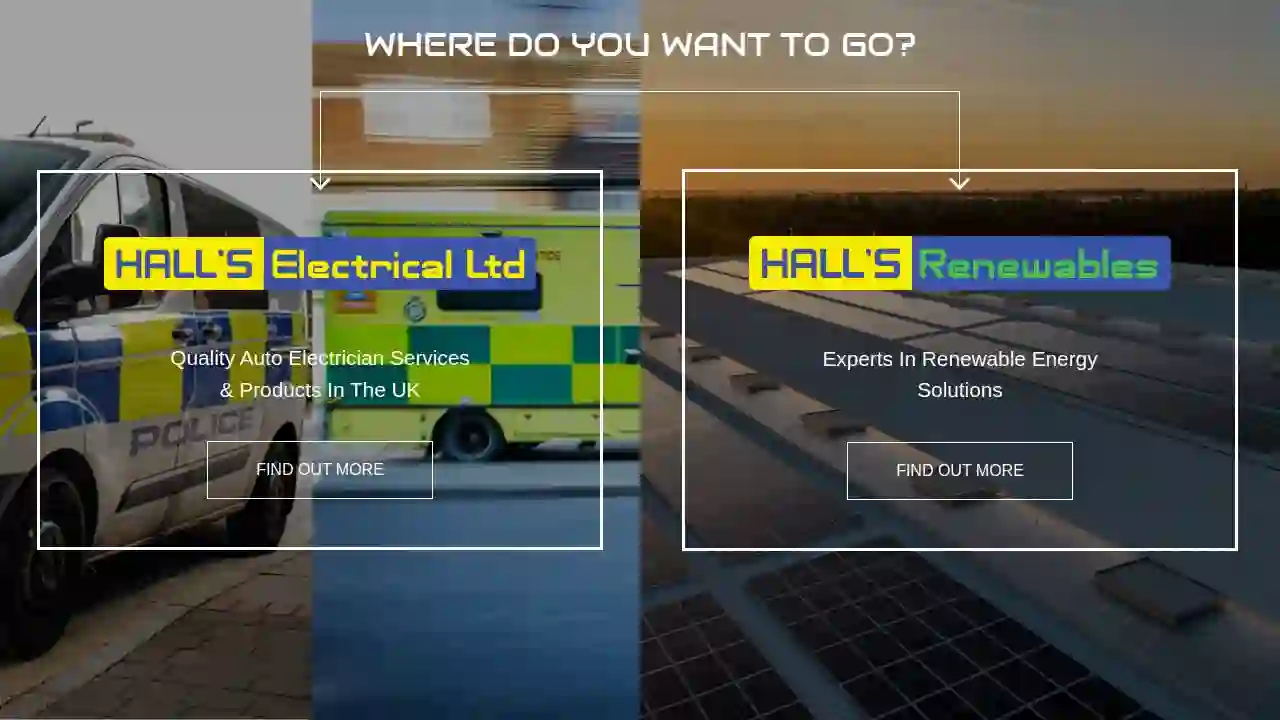Solar Installers Camelford
Top Solar Energy Companies in Camelford
Get multiple Solar Installer quotes for your project today! Compare profiles, reviews, accreditations, portfolio, etc... and choose the best offer.

Recharge Renewable
4.972 reviews6 Knapps Drive, Winscombe, BS25 1BD, GBRecharge Renewable is your local and trusted partner delivering solar panels, solar PV, EV chargers, and battery storage. Specialists in EV charging, PV, and solar panel installation across Somerset. We offer a personal and bespoke design and service to meet your energy needs, ensuring a sustainable and efficient future. Recharge your batteries today!
- Services
- Why Us?
- Accreditations
- Our Team
- Gallery
Get Quote
Ecogen Energy
51 reviews27 Portland Square, Bristol, BS2 8SA, GBPowering the UK with clean energy since 2011, Ecogen Energy (formerly known as Solar Roofing Specialists) helps our clients minimise their energy costs, secure their energy supply for the future, and achieve their sustainability ambitions. We specialise in offering a range of solutions, including solar, battery storage, EV charging, and solar carports, for commercial, residential, and community-based projects. We're committed to providing excellent customer and employee experience. Our team provides end-to-end services, from the initial survey to design, installation, monitoring, operation, and maintenance. We're proud to have over 75 years of combined employee experience and have installed over 105,800 solar panels across 1,829 completed projects, reducing 5,312 tonnes of CO2 annually. As part of our commitment to sustainability, we support charity projects with innovative technologies which enable them to generate revenue and become more environmentally sustainable.
- Services
- Why Us?
- Testimonials
- Gallery
Get Quote
Smart Build Electrical & Solar
55 reviewsExeter, GBSmart Build Electrical Contractors are here for all your electrical needs, big and small, domestic and commercial. We offer a 24/7 emergency service alongside our regular contracting work, covering Cornwall and Devon. We are approved by NAPIT to complete EICRS (landlord tests) and all electrical installs. With over 10 years in the industry, we here at Smart Build have carried out work ranging from new builds and cottage renovations to local authorities and the NHS. From £50 jobs to £500,000 jobs, we are the one-stop shop for all your electrical needs. We offer a friendly free-of-charge consultation service for when you are concerned about anything electrical.
- Services
- Why Us?
- Accreditations
- Gallery
Get Quote
Devon Renewables
Exeter, GBDevon Renewables is an independent, family run business offering solar panels and PV, battery storage solutions and electric vehicle charging for home and business. Our team is fully qualified to supply and install a range of brands and products to suit your needs. This means that we are not biased towards one product, and can give you the best solutions to suit your individual needs and requirements. Based in South Devon, we cover Devon, Cornwall and surrounding areas which means we are local and available for you to contact should you have any questions or any further support after your installation has taken place. Our mission is to help our local communities across South Devon & beyond confidently reduce their energy & fuel costs, lower their carbon footprints & increase the use of sustainable energy throughout Devon. Our guarantee is no pushy sales teams or hidden extra costs, just fully qualified, local installers using trusted products and brands whilst providing high-quality workmanship with after installation support.
- Services
- Why Us?
- Gallery
Get Quote
ECO GREEN PARTNERS LTD
4.712 reviewsLower Strode Rd, Unit 7 Stileway Business Park, Clevedon, BS21 6UU, GBWith over 20 years of experience in the renewable energy industry, Eco Green Partners is a leading provider of sustainable energy solutions. Our unique expertise allows us to select equipment based on key factors such as value for money, life cycle costs, performance, reliability, and warranty. We offer a comprehensive range of services, including the design, installation, and maintenance of air source heat pumps, solar PV & storage systems, and EV chargers. We are committed to helping our customers make the switch to clean and sustainable energy, reducing their carbon footprint and saving money on their energy bills. Our team of experienced engineers is dedicated to providing exceptional customer service and ensuring that every project is completed to the highest standards. Eco Green Partners is a MCS certified company, and we operate in residential, commercial, and industrial sectors. We pride ourselves on delivering value-engineered solutions while maintaining a trouble-free installation process. Our commitment to quality is reflected in our comprehensive insurance-backed warranties and ongoing support. We are proud to be a part of the growing movement towards a greener future.
- Services
- Why Us?
- Accreditations
- Testimonials
- Gallery
Get Quote
Wind & Sun Ltd
4.818 reviewsHereford, GBWorld Class Distributors & Providers of Renewable Energy Solutions Contact us Log in Apply for a trade account Cart Products Products Solar Solar Solar PV Panels Residential and Commercial Solar PV Panels Small Solar PV Panels Solar Inverters String Inverters Hybrid Inverters Optimised Inverters & Optimisers Inverter Monitoring Inverter Monitoring and Communications Inverter Communication Interfaces and Cables Inverter Accessories Inverter Warranties Fronius Extended Warranties SMA Extended Warranties SolarEdge Extended Warranties Solar PV Mounting Systems On Roof Roof Hooks Mounting Rail Profiles Mounting Profile Accessories Module Clamps Trapezoidal Sheet Metal Roof Fixings Corrugated Roof Fixings Screws In Roof Flat Roof FixGrid Pro FixGrid Single Panel Flat Roof Mounts Ground Mount Vehicle Mount Small Solar Panel Mounts Mounting System Accessories Solar Charge Controllers MPPT Charge Controllers PWM Charge Controllers Charge Controller Accessories Battery Storage Battery Storage Inverters On-Grid battery storage inverters Off-Grid battery inverters Off-Grid battery inverter/chargers Hybrid inverters Batteries Lead Acid Batteries Lithium Batteries Battery Storage Accessories Backup Switchgear Battery Accessories Battery Combiners Battery Relays Battery System Monitoring DC-DC Converters Battery Chargers System Accessories Cables, Wiring and Connectors Solar Cable and Connectors Battery/Inverter Cables and Connectors Communication Cables Multi-Core Cables Busbars Accessories Energy Monitoring and Control Battery Monitors Energy Meters and CT Clamps Heating Controllers MY-PV Heating Controls Solar iBoost+ SolarEdge Smart Energy Hot Water Controllers kWh Meters Fuses and Circuit Protection PV Combiner Boxes and String Fuses Battery/Inverter Fuses Labels Labels for Solar PV Systems Labels for Wind Systems Labels for Battery Systems Switches Isolation and Changeover Switches Battery Switches Tools Battery/Inverter Cable Assembly Tools Solar Estimation Tools Solar Cable Assembly Tools Test Meters EV Charging EV Chargers Fronius Wattpilot Home VEVA EV Charger Appliances DC Lighting LED lights Street lights Pumps Submersible pumps Lorentz Self Install Pumps Lorentz Submersible Pumps Low Voltage Submersible Pumps Surface pumps Garden pumps Pump accessories Wind Off-Grid Wind Turbines Off-Grid Wind Turbines Mounting Kits and Towers On-Grid Wind Turbines Britwind Wind Turbines SD Wind Energy Turbines Packages Self-Consumption Battery Storage Packages SMA Sunny Boy Storage Package Fronius GEN24 Hybrid Storage Package Victron ESS Package Commercial Battery Storage Packages Single Cluster 3-Phase SMA Sunny Island Package SMA Sunny Tripower Smart Energy Package Victron EasySolar Off-Grid Packages 12V EasySolar Small Off-Grid AC Package 24V EasySolar Small Off-Grid AC Package 48V EasySolar Small Off-Grid AC Package Off-Grid Home Packages Off-grid Home Kit with BYD lithium batteries Off-grid Home Kit with Rolls lead acid batteries Small Off-Grid Packages Off-Grid Lighting Package 1 Off-Grid Lighting Package 2 Off-Grid Lighting Package 3 Solar Pumping Packages Solar Pumping Package Clearance Brands BYD Carlo Gavazzi DEKS Eland Cables Enwitec Fronius GSE Integration Kraus & Naimer Labcraft Leading Edge Lorentz Marlec Meyer Burger Morningstar my-PV REC Rolls Battery Schletter SMA SolarEdge Stäubli Steca Varta Victron Energy Explore Services System Design Technical support Design a system Island installations Explore Our Installer Network Find the right installer for you Become an Installer Wholesale & Distribution Showroom Sustainable sourcing Buying from Wind & Sun International sales Training Training centre Manufacturer training programmes Local information Training and Events Recycling Recycling solar PV panels Recycling batteries WEEE compliance Support & Advice Types of System Grid connect system Grid connect system with battery storage Small off grid DC/AC system Medium off-grid AC system AC coupled off-grid system Mini-grid off grid system Solar pumping system Applications Boats Off Grid On Grid Rural Electrification Solar Wind All Articles Batteries Generators Installing systems Inverters Off grid Solar power System accessories System design Wind power Advice for Home Owners Power your home Why use an installer? About Us A Business Founded on Sustainability Pioneering in the renewables industry Powering Wind & Sun Our commitment to the environment Procurement Social and ethical The Humber Marsh Nature Reserve Experience Wind & Sun Visit the showroom Meet the team Careers Events Blog News
- Services
- Why Us?
- Gallery
Get Quote
PV Plus Ltd
Winchester Hill, Romsey, Unit 9 Winchester Hill Bus. Park, GBWe specialise in commercial solar panels, providing design, installation and maintenance services for businesses across The South. Our Partners We choose to work with a handful of top quality renewable energy manufacturers to ensure we are only fitting the best technologies. PV Plus works closely with manufacturers to ensure our product knowledge is up to date and are accredited installers for top renewable brands such as Bauder, Tesla, SolarEdge, Enphase and Fronius.
- Services
- Why Us?
- Gallery
Get Quote
Zenith Solar Panels Gloucester
Hempsted, 21 High View, Gloucester, GL2 5LN, GBZenith Solar Panels Gloucester: Leading Solar Solutions for a Sustainable Tomorrow. In Gloucester, Zenith Solar Panels stands as a beacon of the solar energy movement. Fusing advanced technology with deep-rooted local knowledge, we're reshaping how our community engages with the sun's abundant energy. As proud members of the Microgeneration Certification Scheme (MCS) and the Renewable Energy Consumer Code (RECC), our commitment to superior quality and ethical conduct remains paramount. Our technicians, trained by industry-leading institutions, guarantee optimal installation and performance for every solar system. Zenith Solar Panels Gloucester aligns with major industry associations like the Solar Trade Association (STA) and British Renewable Energy Association (BREA), ensuring our solutions are top-tier. But we go beyond installation. In collaboration with local utility companies and schemes like the Smart Export Guarantee (SEG), we turn surplus energy into tangible benefits for Gloucester residents. Choose Zenith for solar in Gloucester. Join us in illuminating a brighter, eco-friendly future.
- Services
- Why Us?
- Accreditations
- Gallery
Get Quote
Hall's Renewables
Bristol, GBHall's Renewables is a leading and trusted company specialising in renewable energy solutions since 1979. We understand the growing importance of sustainable practices and help businesses solve their energy challenges with a unique can-do approach. Our expertise lies in consulting, planning, designing, installing, and maintaining a range of renewable energy products and services, including commercial solar PV, electric vehicle (EV) charging, battery storage, telematics, LED solutions, back office support, operational/maintenance support, and feasibility studies. We pride ourselves on our tailored solutions, which are bespoke to each client's needs and goals. We work closely with our clients to understand their specific requirements and offer solutions that address their unique challenges. Whether it's affordability, energy efficiency, scalability, return on investment, or complex energy needs, we have the experience and expertise to deliver the best possible outcome. Our commitment to adaptability and innovation ensures that we remain at the forefront of the renewable energy industry, providing our clients with the most effective and sustainable solutions available.
- Services
- Why Us?
- Gallery
Get Quote
Avonlea Solar Southwest Ltd
Bristol, GBAVONLEA SOLAR SOUTHWEST LTD is a company that prioritizes customer satisfaction. They offer solar panel repair services, including cleaning and animal proofing, as well as energy efficiency consultation. Their team of engineers is friendly, knowledgeable, and competent, and they pride themselves on providing high-quality workmanship at a competitive price. The company is open Monday to Friday from 8:00 to 17:00 and can be contacted through their website.
- Services
- Why Us?
- Gallery
Get Quote
Over 3,485+ Solar Installers on our directory
Our solar installers operate in Camelford and surroundings!
SolarCompaniesHub has curated and vetted the Best Solar Businesses in and around Camelford. Find a trustworthy pro today.
Frequently Asked Questions About Solar Installers
- Monocrystalline: Made from a single silicon crystal, known for high efficiency (typically 18-22%) and sleek black appearance.
- Polycrystalline: Made from multiple silicon crystals, slightly less efficient (15-17%) but often more affordable than monocrystalline.
- Thin-film: Made from thin layers of photovoltaic material, lower efficiency (8-12%) but can be flexible and lightweight.
- String Inverters: Connect multiple panels in a series (a 'string'). A cost-effective option for simple systems, but a single panel issue can affect the entire string.
- Microinverters: Attach to each individual solar panel, maximizing energy production even if some panels are shaded. They are more expensive but offer greater efficiency and monitoring capabilities.
- Power Optimizers: Similar to microinverters, but less expensive. They optimize the output of each panel and provide individual panel monitoring, but a central inverter is still required.
- Hybrid Inverters: Combine a solar inverter with a battery charge controller, allowing for seamless integration of battery storage.
- Draw electricity from the grid when your solar panels aren't producing enough power (e.g., at night)
- Sell excess solar electricity back to the grid through net metering.
- System size (measured in kilowatts, or kW)
- Type of solar panels (monocrystalline, polycrystalline, thin-film)
- Roof complexity (pitch, size, obstructions)
- Labor costs in your area
- Available incentives and rebates
What are the different types of solar panels?
What are the different types of solar inverters?
What is the difference between grid-tied and off-grid solar systems?
What is the average cost of solar panel installation in UK?
What are the different types of solar panels?
- Monocrystalline: Made from a single silicon crystal, known for high efficiency (typically 18-22%) and sleek black appearance.
- Polycrystalline: Made from multiple silicon crystals, slightly less efficient (15-17%) but often more affordable than monocrystalline.
- Thin-film: Made from thin layers of photovoltaic material, lower efficiency (8-12%) but can be flexible and lightweight.
What are the different types of solar inverters?
- String Inverters: Connect multiple panels in a series (a 'string'). A cost-effective option for simple systems, but a single panel issue can affect the entire string.
- Microinverters: Attach to each individual solar panel, maximizing energy production even if some panels are shaded. They are more expensive but offer greater efficiency and monitoring capabilities.
- Power Optimizers: Similar to microinverters, but less expensive. They optimize the output of each panel and provide individual panel monitoring, but a central inverter is still required.
- Hybrid Inverters: Combine a solar inverter with a battery charge controller, allowing for seamless integration of battery storage.
What is the difference between grid-tied and off-grid solar systems?
- Draw electricity from the grid when your solar panels aren't producing enough power (e.g., at night)
- Sell excess solar electricity back to the grid through net metering.
What is the average cost of solar panel installation in UK?
- System size (measured in kilowatts, or kW)
- Type of solar panels (monocrystalline, polycrystalline, thin-film)
- Roof complexity (pitch, size, obstructions)
- Labor costs in your area
- Available incentives and rebates